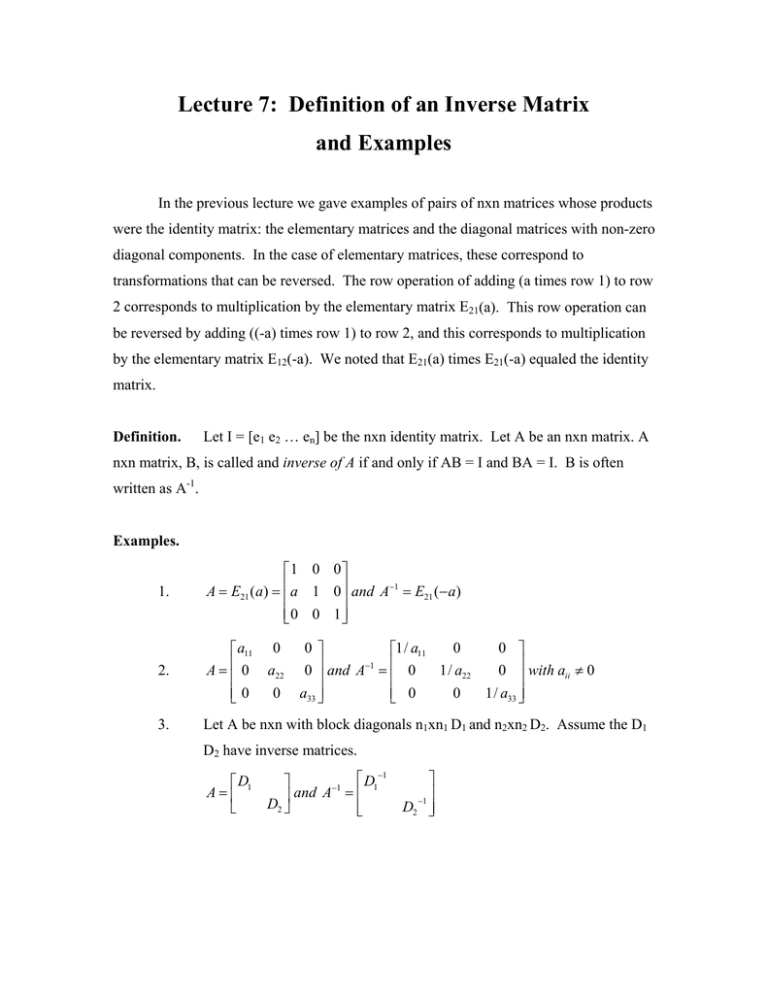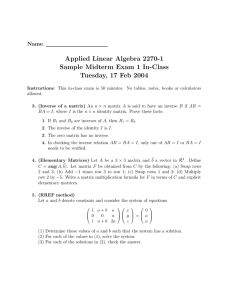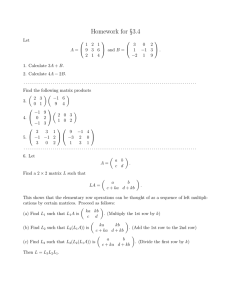Lecture 7: Definition of an Inverse Matrix and Examples
advertisement

Lecture 7: Definition of an Inverse Matrix and Examples In the previous lecture we gave examples of pairs of nxn matrices whose products were the identity matrix: the elementary matrices and the diagonal matrices with non-zero diagonal components. In the case of elementary matrices, these correspond to transformations that can be reversed. The row operation of adding (a times row 1) to row 2 corresponds to multiplication by the elementary matrix E21(a). This row operation can be reversed by adding ((-a) times row 1) to row 2, and this corresponds to multiplication by the elementary matrix E12(-a). We noted that E21(a) times E21(-a) equaled the identity matrix. Definition. Let I = [e1 e2 … en] be the nxn identity matrix. Let A be an nxn matrix. A nxn matrix, B, is called and inverse of A if and only if AB = I and BA = I. B is often written as A-1. Examples. 1. 1 0 0 A = E21 (a) = a 1 0 and A−1 = E21 (− a) 0 0 1 2. a11 A = 0 0 3. Let A be nxn with block diagonals n1xn1 D1 and n2xn2 D2. Assume the D1 0 a22 0 0 0 0 1/ a11 −1 0 and A = 0 1/ a22 0 with aii ≠ 0 0 a33 0 1/ a33 D2 have inverse matrices. D A= 1 D1−1 −1 and A = D2 −1 D2 In order to find an inverse matrix of a given matrix, we must choose the columns of the inverse matrix so that AB = I A [b1 b2 [ Ab1 Ab2 bn ] = [ e1 e2 en ] Abn ] = [ e1 e2 en ] So, Ab1 = e1 , Ab2 = e2 ,… , Abn = en This means col k of B must be the solution of Abk = ek. Example. The following 3x3 matrix will have an inverse matrix, which can be found by solving three algebraic systems with the same coefficient matrix and different right sides. The three systems can be solved by Gauss elimination. Because the coefficient matrix is the same, the first step of the Gauss elimination method can be done simultaneously. 1 2 1 A = 1 3 2 . Solve Ab1 = e1 , Ab2 = e2 , and Ab3 = e3 . 1 0 1 Step 1: Use row operations to transform the "big" 3x6 augmented matrix [A I] to upper triangular [U C] where U is 3x3 upper triangular and C is 3x3. 1 2 1 1 0 0 [ A I ] = 1 3 2 0 1 0 1 0 1 0 0 1 row 2 − row 1 and row 3 − row 1 give 1 2 1 1 0 0 E31 (−1) E21 (−1) [ A I ] = 0 1 1 −1 1 0 0 −2 0 −1 0 1 row 3 + 2(row 2) gives 1 2 1 1 0 0 E32 (2) E31 (−1) E21 (−1) [ A I ] = 0 1 1 −1 1 0 0 0 −2 −3 2 1 Step 2: Use backward substitution to solve the three systems for the columns of B. 1 2 1 b11 1 0 1 1 b = −1 21 0 0 2 b31 −3 b31 = −3 / 2 b21 = −1 − (−3 / 2) = 1/ 2 b11 = 1 − 2(1/ 2) − (−3 / 2) = 3 / 2 1 2 1 b12 0 0 1 1 b = 1 22 0 0 2 b32 2 b32 = 2 / 2 = 1 b22 = 1 − (1) = 0 b12 = 0 − 2(0) − (1) = −1 1 2 1 b13 0 0 1 1 b = 0 23 0 0 2 b33 1 b33 = 1/ 2 b23 = 0 − (1/ 2) = −1/ 2 b13 = 0 − 2(−1/ 2) − (1/ 2) = 1/ 2 3 / 2 −1 1/ 2 So, A = B = 1/ 2 0 −1/ 2 −3 / 2 1 1/ 2 −1 Application to the Two-loop Circuit. As in the previous lecture use R1 = 1, R2 = 2 and R3 so that the coefficient matrix is 1 −1 A = 1 0 0 −2 1 [ A I ] = 1 0 1 −3 and the big 3x6 augmented matrix is −3 −1 1 1 0 0 0 −3 0 1 0 −2 −3 0 0 1 Step 1: Use the same row operations as in the previous lecture to get 1 0 0 1 −1 1 E32 (2) E21 ( −1) [ A I ] = 0 1 −4 −1 1 0 0 0 −11 −2 2 1 Step 2: Use backward substitution to find the columns of B Solve for the first column of B 1 −1 1 b11 1 0 1 −4 b = −1 21 0 0 −11 b31 −2 b31 = −2 /(−11) = 2 /11 b21 = −1 + 4(2 /11) = −3 /11 b11 = 1 − 1(2 /11) + (−3 /11) = 6 /11 The other two column vectors are found in a similar way to get 6 /11 5 /11 −3 /11 A = B = −3 /11 3 /11 −4 /11 . 2 /11 −2 /11 −1/11 −1 In the Matlab demo inv_mat.m the computation of the inverse is illustrated via both row operations and the Matlab command inv(A). In Matlab the solution of Ax = d can be found by either of the Matlab commands x = A\d or x = inv(A)*d. Homework. 1. For all examples of inverses verify that AB = BA = I. 2. In the application to the two-loop circuit use backward substitution to find columns two and three of the inverse matrix. 3. 1 3 5 Find the inverse of A = 0 2 1 . 2 2 0 4. Show, if A has an inverse, then the solution of Ax = d is x = A-1d.




